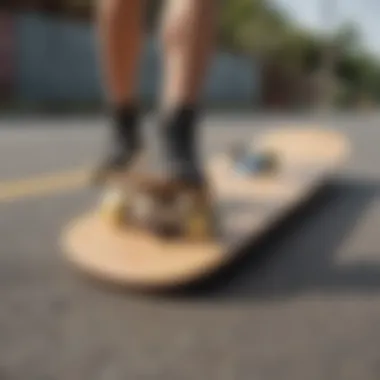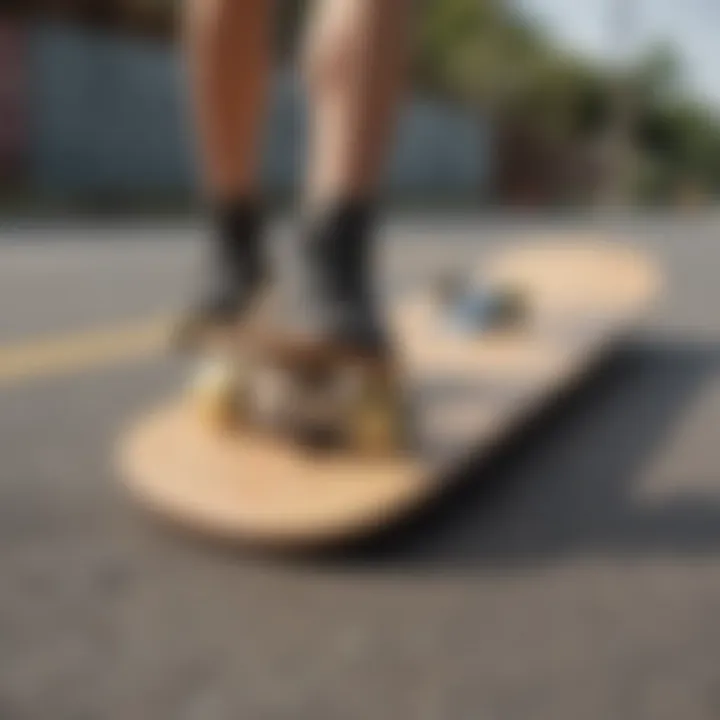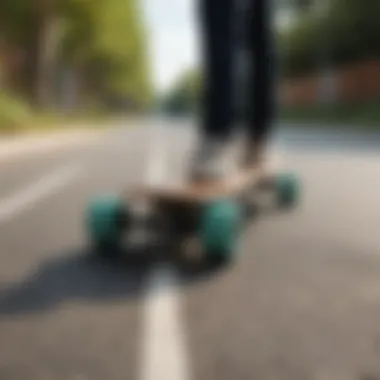Longboard vs. Skateboard: Key Differences Explored


Intro
When we think of popular wheeled sports, two names often rise to the surface: longboarding and skateboarding. These two seemingly similar activities diverge in ways that go beyond their appearances and into deeper cultural roots, design characteristics, and riding experiences. For those who are new or even those just looking to refine their knowledge, understanding these distinctions can make a world of difference in choosing one over the other.
Longboards are generally longer and designed for cruising, carving, and downhill racing, which set them apart from the more compact, trick-oriented skateboards. Each brings its own flair and community vibe, often stirring passionate debates among enthusiasts. This exploration aims to break down the elements that matter most—be it the art of riding, the gear used, and the lifestyle surrounding each sport.
As the discussions unfold, we’ll touch on various angles, from the fundamental construction of the boards to the practicalities of maintaining them. Furthermore, we'll delve into tips that can help both beginners and advanced riders hone their skills. After all, whether you're rolling through the city streets or hitting the skatepark, knowing your board inside and out can enhance your experience tremendously.
Gear Essentials
Choosing the right board can feel like navigating a maze. With a plethora of styles and specifications, it’s vital to know what makes each type unique. Here’s a closer look:
Top Picks for Longboarding and Skateboarding Equipment
- Longboard Options
Sector 9 Lookout Complete Longboard: Known for its stability, this board is great for city cruising.
Land Yachtz Switchblade: Offers versatility for downhill riding and tricking, perfect for those who want to explore different aspects of longboarding. - Skateboard Recommendations
Element Skateboards Section Skateboard: A solid choice for beginners, this board offers durability and style.
Santa Cruz Retro Dot Skateboard: Great for those who appreciate both a vintage look and reliable performance.
Maintenance and Care Tips for Gear
A well-maintained board can drastically improve your ride. Here are some handy maintenance suggestions:
- Regularly check the wheel tightness and if wheels spin smoothly.
- Keep your board clean. Dirt and debris can affect performance significantly.
- Replace worn-out parts promptly. Whether it's grip tape or bearings, don’t let wear hold you back.
Techniques and Tips
Investing in a board comes with instruction. Knowing when to shift your weight, how to maintain balance, and command over steering might be the deciding factor in riding style.
Beginner Tips for Each Sport
For new riders, understanding foundational techniques can pave the way for a smoother ride.
- Longboarding: Focus on learning how to carve. Gradually shifting your weight side to side can help you gain confidence.
- Skateboarding: Getting comfortable with ollies, or jumping the board, is crucial. Practice without movement before trying to incorporate speed.
Advanced Techniques for Skill Enhancement
Once comfortable on your board, elevate your skill set.
- Longboarding: Try your hand at downhill racing, where weight shifts and aerodynamics become crucial for success.
- Skateboarding: Tricks like the kickflip or grind can be challenging but rewarding. Start with basic tricks to build momentum.
"Mastering the art of balance on a longboard or skateboard can be as complex as it is rewarding—every turn teaches something new about the dance between control and freedom."
This in-depth exploration helps in better appreciating the nuanced aspects of both longboards and skateboards, reminding riders that regardless of the choice, personal style and enjoyment at the core matter most. As you navigate through this guide, consider what resonates with you the most and let that guide your decisions, whether cruising through the street or taking on a busy skateboard park.
Preface to Longboarding and Skateboarding
Navigating the world of wheeled sports often leads individuals to the debate between longboarding and skateboarding. Both modes of transport have carved their unique niches, allowing enthusiasts to express themselves in countless ways. Understanding the distinctions between them is crucial, not only for lifestyle choices but also for finding the right fit based on one’s personal preferences and intended use.
Longboarding generally appeals to those looking for a smoother ride, whether in urban environments or while cruising down a scenic path. On the other hand, skateboarding might strike a chord with those who revel in trickery and dynamics, often opting for skate parks or street sessions. One isn’t necessarily better than the other; rather, they serve specific needs and cater to different styles. Taking a closer look at the origins and cultural facets of both boards can better inform potential users as they consider which one might suit them best.
Historical Context
The history of longboarding and skateboarding is rooted in surf culture. Originally, when the surf slowed down or became flat, surfers sought a way to practice their board skills on land. That’s when skateboards emerged in the late 1940s and early 1950s, akin to a wheeled surfboard. The early boards were crafted from a wooden plank with roller skate wheels attached, and they paved the way for contemporary designs.
As the decades unfolded, skateboarding morphed into a standalone sport, particularly gaining traction in the 1970s with the advent of polyurethane wheels, leading to enhanced performance and versatility. Alternatively, longboarding carved its niche as a more relaxed counterpart, often focusing on cruising and downhill riding, using longer decks that provided better stability. Though distinct, both sports share a passionate community deeply intertwined with their respective histories. In recent years, longboarding has surged in popularity, attracting a diverse crowd, eager to explore its various riding styles.
Cultural Significance
The cultural significance surrounding longboarding and skateboarding goes beyond mere sport. Both activities signify a form of rebellion and an alternative mode of transportation that often challenges societal norms. For many, riding isn’t just about getting from point A to point B; it expresses individuality and freedom.
Community engagement plays a vital role in both cultures. Skate parks filled with laughter, camaraderie, and the sound of wheels against concrete reflect a shared space where people congregate regardless of background. For longboarders, gatherings and events often focus on appreciation for scenic rides, balance, and flow.
"Skateboarding and longboarding are not just sports; they're a lifestyle. They unite people from diverse paths of life, fostering friendships that often last long after the wheels stop turning."
With a continuous flow of social media influence, both cultures have also found footing online. Platforms like Facebook and Reddit serve to connect riders, facilitate discussions about techniques, gear, and host local meetups, bridging geographical gaps. The cultural evolution of these sports showcases their substantial impact on youth culture and community development, underscoring their relevance in today’s world.
Defining the Boards


When comparing longboards and skateboards, it's essential to first grasp their defining characteristics. Both types of boards cater to varying styles of riding and different user needs. Understanding what sets these boards apart not only enhances appreciation for each but also guides enthusiasts in choosing which aligns best with their preferences. The nuances in their specifications play a critical role in how they ride, respond, and fit within the riding community.
Longboard Specifications
Length and Width
Longboards generally boast extended lengths, commonly ranging from 33 to 59 inches. Such dimensions provide a broader surface area, offering better stability and balance while riding. This is particularly advantageous when cruising or carving through town. A longer board gives riders the ability to shift their weight more easily, which allows for smoother rides over uneven terrain.
The width generally falls between 8.5 to 10 inches, allowing for greater foot placement options. However, one consideration is the compact nature of standard skateboards, which are often more portable.
Flexibility
Flexibility in longboards is a noteworthy feature, influenced by the materials and construction method used. Many longboards are made from layers of bamboo, maple, or fiberglass, which can offer varying degrees of stiffness. A board that flexes can absorb shocks better, providing a softer ride on rough surfaces.
For those casual rides down the street, this flexibility serves to enhance comfort, especially on uneven pathways. However, over time, flexible longboards may lose some of their responsiveness in sharper turns, a factor to consider depending on your riding style.
Wheel Size and Shape
Wheel size and shape are crucial for the performance of longboards. Typically, longboard wheels range from 65 to 90 millimeters in diameter, with a softer durometer rating to yield a smoother ride over cracks and bumps. These larger, softer wheels grip the ground better, making them ideal for downhill riding or maintaining control during long-distance cruising.
In contrast, while the ride may be smooth, these wheels can wear down more quickly and may not handle high speeds as well as harder skateboard wheels, which favor more agility and trick performance.
Skateboard Specifications
Standard Dimensions
Skateboards nearly all sit at a standard length, around 31 inches, and a width typically between 7.5 to 8.5 inches. This compactness is pivotal for performing tricks and stunts in park settings. The shorter size allows for easier control in flip tricks and spins. That being said, riders who navigate unfamiliar terrain might find themselves struggling with stability compared to longboards.
Material Composition
Traditionally, skateboards are crafted from maple, known for its durability and resilience when subjected to wear and tear. Its rigid quality allows for explosive pops, essential for jump tricks. In some modern setups, materials like bamboo and composite composites are being utilized, offering lighter options that maintain performance. However, one must weigh the tradeoff between weight and grip; heavier boards often provide more control but can be difficult for beginners.
Truck System
A skateboard’s truck system often comprises a pair of solid axles mounted under the board and connected to the wheels, allowing for smooth pivots. The classic kingpin design is favored by many, providing a traditional response that encourages stability while executing tricks. Some skateboards also utilize reverse kingpin trucks, which are designed to promote easier turns but can limit the stability at high speeds.
When it comes to fine-tuning your ride, the opportunitiy to swap truck systems provides a significant edge in customizing your skateboard experience, an appealing factor for dedicated riders
A well-defined board can vastly improve not only your riding experience but also your connection to the culture behind skateboarding and longboarding. So investing time to understand these specifications is critical.
Riding Styles Comparison
The spectrum of riding styles between longboarding and skateboarding unveils not just differing approaches to handling a board, but also a window into the broader lifestyle each art form represents. This section seeks to explore how these unique styles contribute to the identity and functionality of each sport, their benefits, and the specific considerations one must weigh when choosing between the two.
Freestyle Riding on Skateboards
Freestyle riding is often seen as the heart and soul of skateboarding culture. It's all about expressing one's individuality through moves and tricks that blend creativity with technical skills. Freestyle skaters often find themselves performing tricks like grinding, flipping, and spinning while negotiating various types of terrain.
- Variety of Tricks: The skateboard's smaller size and robust design encourage numerous tricks that can be executed on various surfaces. Think about ollies, kickflips, and even the classic shove-it. These moves allow riders to showcase their unique style, making each session different.
- Urban Environment: Skateboarding thrives in urban settings. Skaters often utilize public spaces—such as stairs, ledges, and rails—transforming ordinary surroundings into venues for their expressive stunts. This adaptability leads to a sense of community as skaters congregate in these shared spaces, exchanging tips and inspirations.
- Skill Development: Freestyle riding is an accessible entry point for newcomers. With practice, beginners can develop their skills relatively quickly; indeed, that feeling of landing a new trick is often euphoric. The challenge lies in perfecting those tricks over time, pushing riders to engage in a continual learning process.
In a way, freestyle riding personifies the essence of skateboarding—an ever-evolving dance of balance, skill, and personal style, revealing not just a method of transportation but a form of artistic expression.
Cruising and Carving on Longboards
On the flipping end of the spectrum, cruising and carving define the longboarding experience. It's about grace, fluidity, and embracing the ride itself rather than just the destination. With longer decks and softer wheels, longboards create a vastly different experience—one that prioritizes comfort and smooth rides, often through scenic routes.
- Smooth Ride: The design of the longboard significantly enhances riding satisfaction. The wide wheels absorb bumps and imperfections in the road, making for a less jarring experience. For those commuting through urban areas or simply enjoying a leisurely ride, this feature becomes crucial.
- Carving Techniques: Unlike skateboards, which often prioritize tricks, longboarding emphasizes turning and carving. Bending one's knees and shifting weight allows the rider to carve smooth arcs, resembling a surf style on land. This technique not only feels exhilarating but also enhances control over the board, especially when navigating hills.
- Casual Aesthetic: Cruising invites a more relaxed approach. Many longboarders use their boards to explore local parks, beaches, or neighborhoods. This laid-back style contrasts sharply with the often high-intensity skateboard sessions and cultivates a different kind of community among riders who prefer chatting over competition.
In essence, cruising and carving provide a distinct narrative within longboarding—one focused on the journey, where the open roads become an extension of the rider's spirit, allowing for creativity in the simplest of movements.
"Skateboarding is about making your own rules. Longboarding, however, is about finding your rhythm on the road."
Both riding styles contribute significantly to their respective cultures and communities. While skateboarding serves as an expressive canvas for tricks and individual style, longboarding creates an experience centered around enjoyment and exploration.
Practical Applications
Each form of wheeled recreation comes packed with its unique set of practical applications that cater to different lifestyles, needs, and preferences. Understanding these applications can greatly enhance the riding experience, whether one opts for longboarding or skateboarding. Realizing the nuances of urban commuting and downhill riding adventures can help enthusiasts make more informed decisions, merging functionality with enjoyment. Let’s traverse the dynamic world of riding and examine how both boards serve real-world purposes.
Urban Commuting
Efficiency and Convenience
Urban commuting on a skateboard or longboard is becoming increasingly popular. The efficiency and convenience associated with these boards provides a swift alternative to traditional forms of transport. Riders can dodge traffic snarls, making travel quicker. This is particularly advantageous in crowded urban landscapes.


For instance, zipping across town to grab coffee or heading to class becomes a breeze when one can navigate through tight spaces with a longboard. The lightweight nature of most boards means that riders can just pick them up and carry them easily, allowing for smooth transitions from board to building.
Yet, while efficiency reigns, it does come with trade-offs. Parking a board isn't as straightforward as with a bike, and one must always keep an eye on their gear. But with proper planning, this minor hiccup doesn’t overshadow the advantages.
Terrain Adaptability
Another important aspect of urban commuting is terrain adaptability. Longboards, with their larger wheels and flexible decks, can handle a variety of surfaces, from rough pavement to smoother bike lanes. This mobility makes longboards particularly well-suited for urban environments where uneven surfaces can be a hassle. Skaters, too, have their charms, particularly when sliding past pedestrians and navigating tighter spaces with ease.
A unique feature of this adaptability is the capacity to switch seamlessly between diverse environments. One day, it might be smooth sidewalks, and another day, bumpy back alleys. However, this comes with its own set of challenges, particularly for skateboarders who might struggle on uneven terrain. Ensuring the wheels are appropriate for one's riding style is crucial for a comfortable experience.
Downhill Riding Adventures
Speed and Control
Downhill riding is where the thrill of skateboarding and longboarding truly shines. Riders pushing these boards to their limits experience a rush thanks to the speed and control that are fundamental to this style. Longboards excel in offering a stable ride at high speeds, which is particularly enticing to thrill-seekers. The broader deck and longer wheelbase provide a sense of security while barreling down steep inclines, allowing for exhilarating descents.
Skaters may opt for shorter boards which, while more nimble, require more skill to maintain a safe speed. The riders’ body posture changes dramatically, affecting how control is maintained during high-speed turns. Riders must gauge their comfort levels with speed to find the best fit, making it as much a personal preference as a technical choice.
Safety Considerations
When it comes to safety considerations, tackling downhill adventures introduces a necessity for proper protective gear. The higher speeds naturally raise the stakes of potential accidents. Helmets, knee pads, and wrist guards become essential equipment for both mediums to mitigate risks. The reality of speed is that while it’s thrilling, it can also lead to severe consequences if safety is overlooked.
Additionally, riders need to be aware of their environment. Knowledge about the terrain, road conditions, and even weather can make or break a downhill experience. As the old saying goes, "better safe than sorry." Enthusiasts who prioritize safety tend to have more consistently enjoyable experiences on both boards, reinforcing the idea that thrills need not come at the expense of caution.
"The thrill of downhill riding can only be matched by the peace of mind that comes with safety measures.”
Community and Culture
The world of longboarding and skateboarding is not just about wheels and boards, it plays a vital role in shaping communities and cultures. These communities offer diverse environments where enthusiasts can connect, share tricks, participate in events, and foster new friendships. It's a culture built upon creativity, expression, and shared experiences.
Within these groups, one can find support networks that encourage development, making it easier to learn new styles and skills. Moreover, the culture surrounding both activities champions inclusivity and diversity, leading to a broader acceptance of all riders regardless of age or ability.
Skateboarding Communities
Skate Parks
Skate parks are community hubs for skateboarders. They provide a safe space where riders can practice their skills, create impressive tricks, and engage with fellow enthusiasts. One key characteristic of skate parks is their design, often equipped with features such as ramps, rails, and bowls that enhance the skateboarding experience. This design not only makes for exciting riding opportunities but also attracts beginners eager to learn from more experienced skaters. However, the downside is that not all parks are created equal; some may lack maintenance or sufficient space, limiting the potential for fun and engagement.
"Skate parks are like the beating heart of skate culture—where tricks are born, friendships are forged, and dreams take flight."
Competitive Events
Competitive events in skateboarding add a thrilling edge to the culture. They push riders to hone their skills and showcase their talents in front of an audience. The unique feature of competitive events includes the diversity of disciplines, such as street style, vert, and bowl competitions, allowing skaters to express their personal styles and abilities. Events like these serve as a platform for aspiring pros to gain recognition. Yet, not everyone finds the competitive spirit appealing—some prefer the laid-back vibe of casual riding and view competition as overly intense.
Longboarding Communities
Meetups and Events
Meetups and community events in longboarding foster a sense of camaraderie among riders. These gatherings often occur in picturesque locations where participants can enjoy stunning views while riding together. A prominent characteristic of these events is the welcoming atmosphere, which attracts riders of all skill levels—this encourages those new to longboarding to jump on a board without hesitation. However, a drawback could be the inconsistency in event frequency, depending on the region.
Social Media Influence
Social media has reshaped the landscape of both longboarding and skateboarding communities. Platforms like Instagram and Facebook are essential for sharing tips, tricks, and experiences with a broader audience. The key characteristic of social media is accessibility; riders can learn new techniques by simply scrolling through their feeds. Through platforms such as Reddit, discussions and collaborations spring up continuously, igniting conversations about gear, techniques, and even lifestyle. Yet, an over-reliance on social media can overshadow traditional riding experiences, with some riders missing out on the connectedness that physical meetups offer.
Gear and Equipment
In the thrilling world of longboarding and skateboarding, the right gear plays a pivotal role in ensuring both safety and enhancing the riding experience. Selecting proper equipment is essential for riders of all skill levels, as it directly influences performance, comfort, and safety on the streets or at skateparks.
Skateboard Gear Essentials
Protective Wear
When it comes to protecting oneself, the importance of protective wear cannot be overstated. Many think that only beginners need pads, but seasoned pros also recognize the value of durability in their gear. Helmets, knee pads, and elbow pads form the basic protective arsenal for a skateboarder. The key characteristic of these items is their ability to absorb shocks during falls, which can be rather frequent, especially for those pushing their limits.
One particularly notable feature is the ventilation in modern helmets, which allows airflow, reducing discomfort on hot days. Riders appreciate this added comfort, as it's a feature that can make a difference during extended sessions on the board. However, while it’s crucial to wear protective gear, some riders might find it decreases mobility a tad, especially if poorly fitted. Ultimately, the benefits far outweigh the drawbacks, making protective wear a wise choice.


Accessories
Now, let’s not forget about accessories, which are not only about style but also serve a deifinite purpose. Items like griptape, skate tool kits, and carry bags are essential components that enhance the overall experience. Griptape provides that all-important traction between the rider’s shoes and the skateboard, ensuring they stay put during tricks and maneuvers. The unique feature of quality griptape lies in its durability; it doesn’t wear down quickly and remains functional even in wet conditions.
Furthermore, having a multi-tool at hand for adjustments can save skaters from unexpected mishaps. Accessories might seem trivial, but they play significant roles in maintenance and performance, helping riders stay prepared for anything the environment throws at them.
Longboard Equipment Must-Haves
Custom Setup Options
Custom setup options are among the most appealing aspects of longboarding. Unlike standard off-the-shelf boards, enthusiasts can tailor their longboard setups to meet individual preferences. This includes selecting specific truck widths, wheels, and even the board shape itself. The key feature here is personalization—a longboard can be adjusted for speed, stability, or agility based on personal riding style.
One downside to this freedom of choice is the potential for overwhelming options. Newcomers might feel lost navigating myriad combinations, leading to choices that may not suit their style. However, with some research, the countless ways to personalize a board ensure a tailored riding experience that stays unmatched.
Safety Ambiguities
Safety ambiguities present an interesting aspect of longboarding equipment. Riders frequently justify their choices for setups that may compromise safety in favor of style or performance. For instance, opting for lighter wheels for speed can sometimes lead to a steadier ride, but they could also mean losing grip on certain surfaces. It's a balancing act where risk and reward dance closely together.
An important characteristic of many longboard choices is that manufacturers often prioritize looks over functionality. The unique feature of this caring only about looks is that some boards, while stunning, might not meet the user’s needs for safety. Hence, it’s crucial that riders keep in mind the challenges they might face and carefully weigh their options in both aesthetics and performance.
Remember, a well-prepared rider is often a safe rider. Putting effort into choosing the appropriate gear and equipment pays dividends in a more enjoyable experience.
Environmental Impact
The topic of environmental impact is increasingly relevant in our modern society. As enthusiasts of longboarding and skateboarding, it's important to consider how our choices affect the world around us. Recreational activities often come with a hidden cost to the environment, and both longboards and skateboards are no exceptions. This section dives into the materials used in these boards and the broader implications on sustainability, aiming to shed light on how such factors play a role in shaping the future of these sports.
Materials and Sustainability
When digging into the materials used in longboards and skateboards, one can't overlook the importance of sustainability. Traditionally, skateboards have been made from layers of maple wood, which offers durability but may not be harvested in an eco-friendly manner. On the other hand, many longboards use bamboo or a mix of bamboo and maple, materials that can be more sustainable due to faster growth rates and lower resource requirements.
Here are some specifics on what makes materials more or less sustainable:
- Wood Source: Sourcing from sustainable tree farms versus clear-cutting forests. Ideal options come from managed sources.
- Manufacturing Process: Some companies utilize techniques that reduce waste and energy consumption, while others may have a larger carbon footprint.
- Use of Recycled Materials: Some brands are experimenting with recycled plastics or composites. This reduces waste and cuts down on new material requirements.
This potential for sustainability opens up options for consumers who are conscious about their environmental footprint. More riders are looking for choices that align with eco-friendly practices, making it vital for brands to adapt.
Carbon Footprint Considerations
Next up, let’s address what is often the elephant in the room: the carbon footprint of our beloved longboards and skateboards. Every stage of a board's life cycle, from production to disposal, carries a diverse carbon cost.
To wrap one’s head around carbon footprints:
- Production Emissions: Creating longboards can involve energy-intensive manufacturing processes. Depending on the materials, this can increase the greenhouse gases emitted. The choice of materials matters here — bamboo boards often have a lower impact compared to those made solely from traditional hardwood.
- Transportation Impact: Consider where a board is produced and how far it travels to reach the user. A board crafted in a nearby facility can save emissions compared to one flown halfway across the globe.
- End-of-Life Disposal: What happens when a board is no longer usable? Throwing it in a landfill isn’t the eco-friendliest option. Brands embracing recycling programs or biodegradable materials help mitigate this issue.
Taking all of these elements into account, an educated consumer can make choices that reduce their total impact on the environment. This understanding elevates the conversation around longboarding and skateboarding beyond mere recreation and into the realm of responsibility.
"As we roll through life on our boards, we should think about the path we leave behind — both for ourselves and our planet."
The End: Longboard or Skateboard?
Deciding between a longboard and a skateboard is not just about picking a board; it’s a matter of personal preference that blends lifestyle, comfort, and desired riding experience. This comparison is crucial as it can shape how enthusiasts engage with their environment, whether they're navigating city streets, cruising along the beach, or performing stunts at a skate park. Understanding the distinct characteristics of each board allows riders to align their choice with their personal needs and riding style, ensuring that every push on the pavement resonates with their unique rhythm.
Personal Preference Analysis
When considering personal preference, each rider must reflect on their own goals and experiences. Length, flexibility, and intended use are factors that play into this decision.
For instance, a rider who frequents downhills may lean toward a longboard, appreciating its stability and larger wheels that grip better on steep inclines. In contrast, someone who thrives on tricks and flips might opt for a skateboard, with its shorter deck allowing for quicker maneuvers.
Some key points to ponder include:
- Purpose of Riding: Are you commuting, doing tricks, or cruising leisurely?
- Skill Level: Beginners may find longboards easier to master due to their stability, while more experienced riders may prefer the challenge of skateboarding.
- Surface Type: Longboards excel on smooth pavements, while skateboards can handle rougher terrains in skate parks.
Ultimately, the nuances of personal experience will greatly sway an individual’s choice. One might find joy in longboarding’s flowing movements, while another might dig the adrenaline rush from skateboard tricks. Each decision leads to a different journey.
Future Trends in Riding
The waves of longboarding and skateboarding are ever-evolving, influenced by advances in technology and growing environmental awareness. One emerging trend is the rise of electric skateboards and longboards, which combine traditional designs with modern conveniences, catering to the need for effortless commuting. These boards offer a new dimension to riding, allowing for longer distances with less physical effort.
Moreover, sustainable manufacturing is gaining traction. Inline with global efforts to combat climate change, both longboard and skateboard manufacturers are exploring eco-friendly materials and production methods. Riders are becoming more conscious of their environmental impact, leading to demand for products that reflect a commitment to sustainability. This blend of passion for riding and environmental responsibility could alter how boards are crafted in the future.
In summary, whether drawn to the freedom of longboarding or the thrill of skateboarding, aficionados must continually evaluate their choices against personal style and future advancements. The boards are more than just tools; they are extensions of a rider’s identity and culture.



